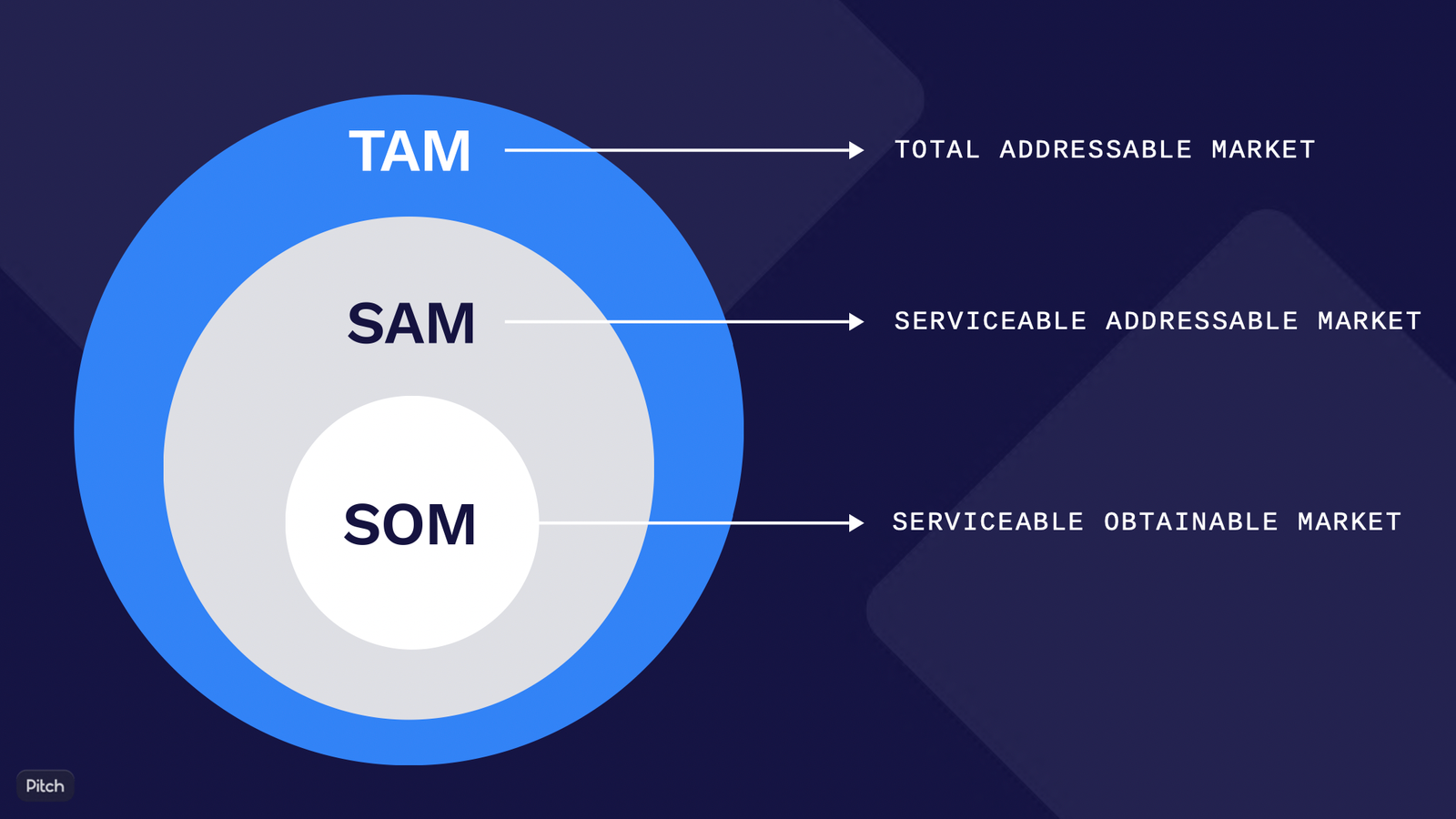VC Insights: How to Calculate and Present Your Startup’s Total Addressable Market (TAM)

Last Updated: March 25, 2025
For startup founders seeking venture capital funding, understanding and effectively communicating your Total Addressable Market (TAM) is crucial. TAM is a key metric that venture capitalists (VCs) use to evaluate a startup’s potential for growth and return on investment.
This article will guide you through the process of calculating and presenting your TAM, including how to calculate total addressable market using different methods, providing insights into how VCs assess this critical metric.

Understanding TAM, SAM, and SOM
Before diving into the calculation methods, it’s essential to understand the distinction between TAM, SAM (Serviceable Available Market), and SOM (Serviceable Obtainable Market). These three metrics provide a comprehensive view of your startup’s market opportunity:
-
- Total Addressable Market (TAM): This represents the total market demand for your product or service. It’s the maximum amount of revenue you could generate if you captured 100% of the market. When calculating TAM, consider both existing market size and potential market growth. For example, if you’re developing a new type of electric vehicle battery, your TAM might include not just the current EV market, but also a portion of the traditional combustion engine market that could transition to electric in the future. It’s important to use reliable data sources and make reasonable assumptions when projecting market growth to ensure your TAM calculation is credible to investors.
- Serviceable Available Market (SAM): This is the segment of the TAM that you can realistically target with your product or service, considering factors like geography, regulations, and your business model. When determining your SAM, be specific about the constraints that limit your addressable market. For instance, if you’re developing a fintech solution, regulatory constraints might limit you to operating in certain countries initially. Similarly, if your product is designed for enterprise customers, your SAM would exclude small businesses and consumers from your TAM. Your SAM calculation should reflect a deep understanding of your target market and the specific barriers to entry you might face in different segments. This serviceable addressable market is crucial for understanding how companies like Airbnb and Amazon assess their competitive advantages and market capabilities.
- Serviceable Obtainable Market (SOM): This is the portion of the SAM that you can realistically capture, considering factors like competition, resources, and your go-to-market strategy. Your SOM should reflect a realistic assessment of your competitive advantages and limitations. Consider your company’s unique value proposition, your marketing and sales capabilities, and your capacity to deliver and support your product or service. For example, if you’re a B2B SaaS startup, your SOM might be limited by your sales team’s capacity to acquire and onboard new customers in the first few years of operation. It’s often helpful to present different SOM scenarios (conservative, moderate, aggressive) based on different assumptions about your growth and market penetration rates.
While TAM gives VCs an idea of the overall market size, SAM and SOM provide a more realistic picture of your startup’s immediate and medium-term potential. VCs will typically want to see all three metrics to understand how you’re thinking about your market opportunity and growth trajectory.
Methods for Calculating TAM
There are three primary methods to calculate TAM:
1. Top-Down Approach
The top-down approach, also known as the top down method, starts with the largest possible market and narrows it down based on relevant factors. This method often relies on industry reports and market research.
Steps:
- Identify the broadest market your product could serve. This step requires thinking expansively about your product’s potential applications. Consider neighboring markets or alternative use cases that might not be immediately obvious. For example, a new collaboration software might serve not just the business market, but also educational institutions or non-profit organizations.
- Find reliable market size data for this broad market. Utilize reputable sources such as industry reports from government statistics, or public financial reports of major companies in the space. Be prepared to justify your data sources to investors.
- Apply relevant limiting factors (e.g., geography, customer segments) to narrow down the market. Be systematic and realistic in applying these factors. Consider creating a decision tree or funnel diagram to visually represent how you’re narrowing down the market. This can help investors understand your thought process and the assumptions underlying your TAM calculation.
Example:
If you’re developing a new type of electric scooter, you might start with the global personal mobility market size, then narrow it down to electric vehicles, and further to electric two-wheelers in your target regions. You might further refine this by considering factors like urban population percentage, average income levels in your target markets, and regulatory environments favorable to electric scooters.
2. Bottom-Up Approach
The bottom up method starts with your specific product or service and builds up to the total market size. This method is often considered more accurate but can be more time-consuming.
Steps:
-
- Identify your ideal customer profile. This step involves creating a detailed persona of your target customer, including demographic information, psychographics, and specific pain points your product addresses.
- Determine the total number of potential customers fitting this profile. Use reliable data sources such as industry reports, government databases, or specialized market research to quantify your target market, and be prepared to justify your sources and methodology to investors.
- Calculate the potential revenue per customer. Consider different pricing models and usage scenarios to arrive at an average revenue figure, and be sure to account for factors like customer lifetime value and potential upsells or cross-sells.
- Multiply the number of potential customers by the revenue per customer. This final step gives you your TAM, but remember to clearly document your assumptions and calculations, as investors will likely scrutinize this figure closely.
Example:
For a B2B SaaS product, you might identify the number of businesses in your target industry and size range, estimate the number of potential users per business, and multiply by your expected annual revenue per user.
3. Value Theory Approach
This approach, known as the value theory method, is useful when you’re creating a new market or significantly changing an existing one. It focuses on the potential value your solution provides to customers.
Steps:
-
- Identify the problem your product solves.
- Estimate the value of solving this problem for a single customer.
- Determine how many potential customers have this problem.
- Multiply the value per customer by the number of potential customers.
Example:
If you’re developing a new AI-powered tool that saves companies 100 hours of work per year, you could multiply the number of potential customer companies by the value of 100 hours of their employees’ time.
4. Using Average Revenue to Estimate Market Size
Average revenue is a crucial metric in estimating market size. It represents the average amount of money that a customer spends on a product or service. To estimate market size using average revenue, startups can use the following formula:
Market Size = Average Revenue x Number of Potential Customers
For example, if a startup has an average revenue of $100 per customer and estimates that there are 10,000 potential customers in the market, the market size would be:
Market Size = $100 x 10,000 = $1,000,000
However, using average revenue to estimate market size has its limitations. It assumes that all customers will spend the same amount of money, which may not be the case. Customer spending can vary widely based on factors such as demographics, purchasing power, and usage patterns. Additionally, this method does not take into account other factors that can impact market size, such as competition and market saturation.
To mitigate these limitations, startups should segment their potential customers and calculate average revenue for each segment. This approach provides a more nuanced and accurate estimate of market size. For instance, if a startup targets both small businesses and large enterprises, the average revenue per customer will likely differ between these segments, and this should be reflected in the market size calculation.

Role of TAM in VC Valuation
VCs use TAM as a critical component in evaluating a startup’s potential. Here’s how TAM factors into their decision-making process:
-
- Growth Potential: A large TAM suggests significant room for growth, which is attractive to VCs looking for high-return investments.
- Market Validation: A substantial TAM indicates that there’s a real, significant problem that your startup is addressing.
- Competitive Landscape: TAM helps VCs understand how much market share you need to capture to be successful and how much room there is for competitors.
- Scalability: A large TAM suggests that your business model has the potential to scale significantly.
- Exit Potential: VCs often look for TAMs in the billions, as this increases the likelihood of a substantial exit (acquisition or IPO) that will provide strong returns.
When presenting your TAM to VCs, it’s crucial to show how you’ve derived your numbers and to be realistic about your SAM and SOM. VCs will be skeptical of inflated numbers or unrealistic market capture projections.
The Importance of Accurate Market Sizing for Fundraising
Accurate market sizing is crucial for fundraising. Venture capitalists (VCs) use market size to assess the potential return on investment (ROI) based on the relative ownership they would purchase in a company and the potential value of the company at exit. A well-thought-out market size calculation can convince potential investors of a startup’s understanding of the playing field and its potential for growth.
In contrast, an inaccurate market size calculation can lead to a lack of confidence in the startup’s ability to execute its business plan. This can make it more challenging to secure funding and can ultimately impact the startup’s ability to grow and succeed.
To ensure accurate market sizing, startups should use a combination of top-down and bottom-up approaches, taking into account factors such as competition, market saturation, and customer behavior. By doing so, startups can create a comprehensive and realistic market size calculation that will help them secure funding and drive growth.
For example, a startup developing a new health tech product might use a top-down approach to identify the overall healthcare market size and then narrow it down to the specific segment they are targeting. Simultaneously, they could use a bottom-up approach to estimate the number of potential customers and the average revenue per customer. Combining these methods provides a more robust and credible market size estimate.
Accurate market sizing not only helps in securing funding but also informs strategic decisions, such as product development, marketing strategies, and resource allocation. It provides a clear understanding of the market opportunity and helps startups align their efforts with the most promising segments.
By presenting a well-researched and realistic market size to VCs, startups can demonstrate their market knowledge and strategic thinking, increasing their chances of securing the necessary funding to grow and succeed.
Join the tribe
Receive a free white paper on “Founder Coaching” and its benefits by signing up to our mailing list. We provide practical advice and helpful reflections to reach your full potential in work and life.

Examples of TAM Calculations
Let’s look at two examples of TAM calculations to illustrate these methods in action:
Example 1: B2C Fitness App
Suppose you’re developing a premium fitness app targeting working professionals in major U.S. cities.
Top-Down Approach:
-
- U.S. fitness app market size: $1.1 billion
- Premium segment (30% of market): $330 million
- Working professionals in major cities (40% of premium segment): $132 million
Bottom-Up Approach:
-
- Working professionals in major U.S. cities: 20 million
- Percentage likely to use a fitness app (30%): 6 million
- Percentage willing to pay for premium features (20%): 1.2 million
- Annual subscription price: $100
- TAM: 1.2 million * $100 = $120 million
In this case, the bottom-up approach provides a more conservative and likely more realistic TAM.
Example 2: B2B SaaS for Restaurants
Consider a startup developing inventory management software for restaurants.
Bottom-Up Approach:
-
- Number of restaurants in the U.S.: 660,000
- Percentage of restaurants that could benefit from advanced inventory management (excluding small, family-run establishments): 40%
- Target market: 264,000 restaurants
- Annual subscription price: $2,000
- TAM: 264,000 * $2,000 = $528 million
Value Theory Approach:
-
- Average annual food waste cost per restaurant: $50,000
- Estimated savings from using your software: 20%
- Value provided per restaurant: $10,000
- Number of potential customers: 264,000
- TAM: 264,000 * $10,000 = $2.64 billion
The value theory approach suggests a larger TAM, but you’d need to justify why restaurants would be willing to pay based on the value provided.

Common Flaws in TAM Calculations
Calculating Total Addressable Market (TAM) is a crucial step for any startup attempting to forecast revenue growth or gauge the profit potential of a specific industry. However, there are common flaws in TAM calculations that can lead to inaccurate results. Here are some of the most common mistakes:
-
- Overestimating Market Size: One of the most frequent errors is overestimating the market size. This often happens when startups use overly optimistic assumptions about the number of potential customers or the average revenue per user. For instance, assuming that every person in a broad demographic will become a customer can inflate your TAM unrealistically.
- Underestimating Competition: Another common flaw is underestimating the competition in the market. Startups may assume they will capture a larger market share than is feasible, leading to an overestimation of their TAM. It’s essential to consider the competitive landscape and realistically assess how much of the market you can capture.
- Using Outdated Data: Relying on outdated data can also lead to inaccurate TAM calculations. Market trends and customer behaviors can change rapidly, making it essential to use the most current data available. For example, a market report from five years ago may not reflect recent technological advancements or shifts in consumer preferences.
- Not Accounting for Market Saturation: Failing to account for market saturation can skew your TAM calculations. As a market becomes more saturated, the potential for growth decreases, and the TAM may be lower than initially estimated. It’s crucial to consider how many competitors are already serving the market and the level of unmet demand.
- Not Considering the Business Model: The business model of a startup can significantly impact the TAM calculation. For example, a subscription-based model may have a different TAM than a one-time payment model. It’s important to align your TAM calculation with your business model to ensure accuracy.
- Failure to Segment Properly: Not all customers in your TAM are equally valuable or accessible. Proper segmentation is crucial for accurate SAM and SOM calculations. Without detailed segmentation, you might overestimate the portion of the market you can realistically serve or capture. This can lead to unrealistic projections and misallocation of resources in your go-to-market strategy.
- Relying Too Heavily on Secondary Data: While industry reports are useful, they may not capture the unique aspects of your market. Primary research can provide valuable insights that generic reports might miss. Conducting surveys, interviews, or focus groups with potential customers can help validate your assumptions and provide a more accurate picture of your specific market opportunity.
- Neglecting International Markets: If your product has global potential, don’t limit your TAM to a single country unless you have a compelling reason to do so. Failing to consider international markets can significantly underestimate your true TAM. However, when including international markets, be sure to account for differences in regulations, cultural preferences, and competitive landscapes that might affect your ability to penetrate these markets.
By avoiding these common pitfalls, startups can present a more accurate and credible TAM to potential investors, enhancing their chances of securing funding and developing realistic growth strategies.
Tools and Resources for TAM Calculation
Several tools and resources, including market research firms, can assist in calculating and presenting your TAM:
-
- Market Research Reports: Reports from firms like Gartner, Forrester, or IBISWorld can provide valuable market size data and projections.
- Government Databases: Organizations like the U.S. Census Bureau or the Bureau of Labor Statistics offer free, reliable data on population, businesses, and economic indicators.
- Industry Associations: Many industry associations conduct and publish market research relevant to their sectors.
- CRM and Analytics Tools: Platforms like Salesforce or HubSpot can help you analyze your customer data to inform bottom-up TAM calculations.
- Survey Tools: Services like SurveyMonkey or Google Forms can help you conduct primary research to validate your TAM assumptions.
- Data Visualization Tools: Tools like Tableau or PowerBI can help you create compelling visual representations of your TAM, SAM, and SOM.
- TAM Calculator Tools: Some consulting firms and VC organizations offer online TAM calculator tools, though these should be used cautiously and cross-checked with other methods.
Remember, while these tools can be helpful, they’re no substitute for critical thinking and thorough research. VCs will be more impressed by well-reasoned, conservative estimates backed by solid data than by flashy numbers without substance.
Presenting Your TAM to VCs
When presenting your TAM to VCs, keep these key points in mind:
-
- Be Transparent: Clearly explain your calculation methods and assumptions. VCs appreciate honesty and will likely probe into your methodology.
- Show Your Work: Provide a clear breakdown of how you arrived at your TAM, SAM, and SOM figures. This demonstrates the rigor of your analysis.
- Use Visual Aids: A simple, clear visual representation of your TAM, SAM, and SOM can be very effective. A funnel diagram is a common and intuitive way to present these metrics.
- Contextualize Your Numbers: Relate your TAM to familiar market sizes or company revenues to give VCs a frame of reference.
- Discuss Growth Potential: Show how your TAM might evolve over time, considering market trends and your product roadmap.
- Address Limitations: Acknowledge any limitations in your calculation methods or data sources. This shows that you’ve thought critically about your analysis.
- Connect TAM to Your Strategy: Explain how your understanding of the market informs your product development, go-to-market strategy, and growth plans.
Remember, VCs are not just evaluating your TAM; they’re evaluating your ability to think critically about your market opportunity and your potential to capture a significant portion of it.
Conclusion
Calculating and presenting your startup’s TAM is a crucial skill for founders seeking venture capital. A well-researched and clearly presented TAM demonstrates your understanding of your market opportunity and your potential for growth.
By using a combination of top-down, bottom-up, and value theory approaches, you can develop a comprehensive view of your market size. Remember to be realistic in your estimates, transparent in your methods, and clear in your presentation.
Your TAM is just one piece of the puzzle that VCs consider, but it’s an important one. It sets the stage for discussions about your business model, go-to-market strategy, and growth potential. A solid TAM analysis can be the foundation for a compelling investment pitch.
As you refine your TAM calculations and presentation, keep in mind that this is an ongoing process. Your understanding of your market will evolve as your startup grows and as market conditions change.
Want to learn more?
Ready to take your startup to the next level? Subscribe to our newsletter for more founder-focused insights delivered straight to your inbox. We regularly share practical tips and strategies on topics like outsourcing, managing remote teams, building company culture, motivating employees, and many more.
For more in-depth content, explore our blog section. You’ll find articles on a wide range of startup challenges, from leadership and team management to growth strategies and fundraising.
Need personalized guidance? We’re here to help. Our team of experienced startup coaches offers tailored support to address your specific needs. Whether you’re struggling with team dynamics, strategic planning, or any other aspect of startup management, we can provide the expertise you need to overcome obstacles and drive your business forward. Now, we also offer a free consultation to see whether there is a fit.
Don’t hesitate to reach out – let’s build your startup success story together.
Interested in Coaching?
Schedule a Free Call

Understanding the Venture Capital Raising Process: A Step-by-Step Guide for Founders
Raising venture capital is a critical milestone for many startups, providing the necessary fuel for rapid growth and scaling. However, the fundraising process can be complex, filled with unfamiliar terms and intricate mechanics.

Top HR Software Solutions for Startups – Features, Pricing and Comparisons
For startups, managing human resources effectively is crucial for growth and success. As teams expand and operations become more complex, the right HR software can streamline processes, ensure compliance, and foster a positive work environment.

How Startup Equity Works: Key Concepts, Vesting, and Calculation Explained
Startup equity is a fundamental concept for founders and early employees, yet it’s often misunderstood. This guide breaks down the essentials of startup equity, from basic definitions to complex calculations, helping you navigate this crucial aspect of your company’s financial structure.

Join the tribe
Receive a free white paper on what “Founder Coaching” is and its benefits by signing up to our mailing list. We provide practical advice and helpful reflections to reach your full potential in work and life.
Frequently asked questions
Who can benefit from Coaching?
Our coaching is tailored to founders of startup companies who seek to grow their businesses, develop personal leadership skills, and maintain their health under pressure.
How do I join Advance Coaching?
Interested founders can set up a discovery call through our website. The application process includes a brief questionnaire about your startup and goals, followed by a consultation call to ensure our program aligns with your needs.
What results can I expect from coaching?
Coaching addresses the areas of your work / life that you want to improve. Whether that is in specific aspects of leadership skills, having more clarity and confidence in your business positioning and strategy, resolving conflicts with your Co-Founder or experiencing enhanced personal health – coaching will identify and strengthen your unique areas for growth.
What is the cost of Advance Coaching?
Pricing depends on your individual needs. Please book a Discovery call to find out more.


